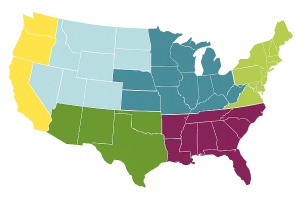Georgia Native Plants, State Flower & State Bird
Posted By American Meadows Content Team on Sep 27, 2012 · Revised on Oct 26, 2025

Knowing your location helps us recommend plants that will thrive in your climate, based on your Growing Zone.
Posted By American Meadows Content Team on Sep 27, 2012 · Revised on Oct 26, 2025
Native plants are adaptable, low-maintenance, and beautiful. They are the best choice for habitat-friendly gardens and thriving ecosystems. Find top picks for native plants in your state - and learn about your state bird and state flowers!
Follow Along With More Of Our Guides
Hello native plant enthusiasts! In the list below, you will find popular native plants and wildflower seeds, available from American Meadows, that have a native distribution in your state. You’ll also find information about your state bird, state flower, and state wildflower!
Grow our Native Southeast Wildflower Seed Mix!
Virginia Bluebells (Mertensia virginica)
Cliff Goldenrod (Solidago drummondii)
Showy Goldenrod (Solidago speciosa)
Wrinkleleaf Goldenrod (Solidago rugosa)
Perennial Lupine (Lupinus perennis)
Black Eyed Susan (Rudbeckia fulgida)
Black Eyed Susan or Gloriosa Daisy (Rudbeckia hirta)
Purple Coneflower (Echinacea purpurea)
Pale Purple Coneflower (Echinacea pallida)
Yellow Prairie Coneflower (Ratibida columnifera)
Gray Headed Coneflower (Ratibida pinnata)
Butterfly Weed (Asclepias tuberosa)
Swamp Milkweed (Asclepias incarnata)
Common Milkweed (Asclepias syriaca)
White Trillium (Trillium grandiflorum)
Red Trillium (Trillium erectum)
Painted Trillium (Trillium undulatum)
Rose Trillium (Trillium catesbaei)
White Tinged Sedge (Carex albicans)
Appalachian Sedge (Carex appalachia)
Wild Strawberry (Fragaria virginiana)
Plains Coreopsis (Coreopsis tinctoria)
Pink Coreopsis (Coreopsis rosea)
Lanceleaf Coreopsis (Coreopsis lanceolata)
Wild Bergamot (Monarda fistulosa)
Wild Geranium (Geranium maculatum)
Elderberry (Sambucus canadensis)
Phlox divaricata (Woodland Phlox)
Obedient Plant (Physostegia virginiana)
Red Cardinal Flower (Lobelia cardinalis)
Blazing Star (Liatris spicata)
Bottlebrush Grass (Elymus hystrix)
Muhly Grass (Muhlenbergia capillaris)
Big Bluestem (Andropogon gerardii)
Little Bluestem (Schizachyrium scoparium)
Northern Sea Oats (Chasmanthium latifolium)
Yellow Prairie Grass (Sorghastrum nutans)
Smooth Blue Aster (Symphyotrichum laeve)
New England Aster (Symphyotrichum novae-angliae)
Sky Blue Aster (Symphyotrichum oolentangiense)
Common White Yarrow (Achillea millefolium)
Heliopsis (Heliopsis helianthoides)

Brown Thrasher ~ Toxostoma rufum
The Brown Thrasher is one of the finest songsters native to America. Farmers hearing him during spring planting say he is giving them advice: drop it drop it, cover it cover it, pull it up pull it up. Though part vegetarian, the Thrasher is a true friend to the farmer since he feeds on destructive grasshoppers, caterpillars, and worms. Some believe he was named for his habit of hopping around and searching for insects under leaves, while others think he may have been named for the way he thrashes large insects to death, or for the way he switches his long tail back and forth.
Cherokee Rose ~ Rosa laevigata
A high-climbing shrub, the wild Cherokee Rose frequently attains the height of a sprawling vine. It is excessively thorny and generously supplied with vivid green leaves. Its blooming time is in the early spring but favorable conditions will produce a second flowering in the fall of the year. Because of its hardy nature, the plant is well adapted to hedge purposes and is often used in this capacity throughout the South. Although thought to be of Chinese origin, the Cherokee Rose derived its American name from the Cherokee Indians.
From The Wildflowers of the 50 States U.S. stamps issues July 24, 1992:

